The 2024 "Cryptocurrency Status Report" points out that cryptocurrency activity has reached an all-time high, stablecoins have become a key application, improvements in blockchain infrastructure have reduced transaction costs, and the intersection of cryptocurrency with emerging fields such as artificial intelligence and social networks shows strong growth potential.
Author: a16z Crypto
Translation: Baihua Blockchain

Two years ago, when we released the first annual "Cryptocurrency Status Report," the world looked very different from today. Cryptocurrency had not yet become a priority for policymakers, and Bitcoin and Ethereum exchange-traded products (ETPs) had not yet received approval from the U.S. Securities and Exchange Commission (SEC). Ethereum had not yet switched to the energy-efficient proof-of-stake (PoS) mechanism, and second-layer (L2) networks were largely stagnant, with occasional transactions occurring at costs far higher than today.
However, with the release of our newly published 2024 "Cryptocurrency Status Report," the situation has changed. The report covers the rise of cryptocurrency as a hot policy topic, many technological advancements in blockchain networks, and the latest trends between builders and users in the cryptocurrency industry. The report also:
- Delves into the emergence of key applications, such as stablecoins—one of the "killer applications" of cryptocurrency;
- Explores the intersection of cryptocurrency with other key technological trends (such as artificial intelligence, social networks, and gaming);
- Shares new data on interest in cryptocurrency in key swing states ahead of the U.S. elections, among other insights.
The 2024 "Cryptocurrency Status Report" also reveals a historic high in cryptocurrency activity and analyzes the maturation process of blockchain infrastructure—especially how recent scaling upgrades have significantly reduced on-chain transaction costs, while the rise of Ethereum L2 and other high-throughput blockchains has also had a huge impact.
This year, we also launched a new tool: the a16z Cryptocurrency Builder Vitality Dashboard. For the first time, we will share proprietary data based on our unique perspective, including the distribution of "builder vitality." This dashboard aggregates thousands of data points from our investment team's research, our CSX startup accelerator program, and other industry tracking, all of which have been aggregated and anonymized. Through this tool, anyone can explore how cryptocurrency builders view their activities and interests—from the blockchains they are building on to the types of applications they are creating, as well as the technologies they are using and their locations. We plan to update this data annually as part of our annual "Cryptocurrency Status Report."
Next are the key findings from our 2024 "Cryptocurrency Status Report."
7 Key Conclusions:
- Cryptocurrency activity and usage have reached an all-time high.
- Cryptocurrency has become an important political issue ahead of the U.S. elections.
- Stablecoins have found product-market fit.
- Infrastructure improvements have increased capacity and significantly reduced transaction costs.
- Decentralized finance (DeFi) remains popular and is growing.
- Cryptocurrency is expected to address some urgent challenges in artificial intelligence.
1. Cryptocurrency activity and usage have reached an all-time high
The number of active cryptocurrency addresses has never been so high. In September 2023, there were 220 million addresses that had interacted with the blockchain at least once, more than tripling from the end of 2023. (As a benchmark, active addresses are less susceptible to manipulation than other metrics. For more details on this, see here.)
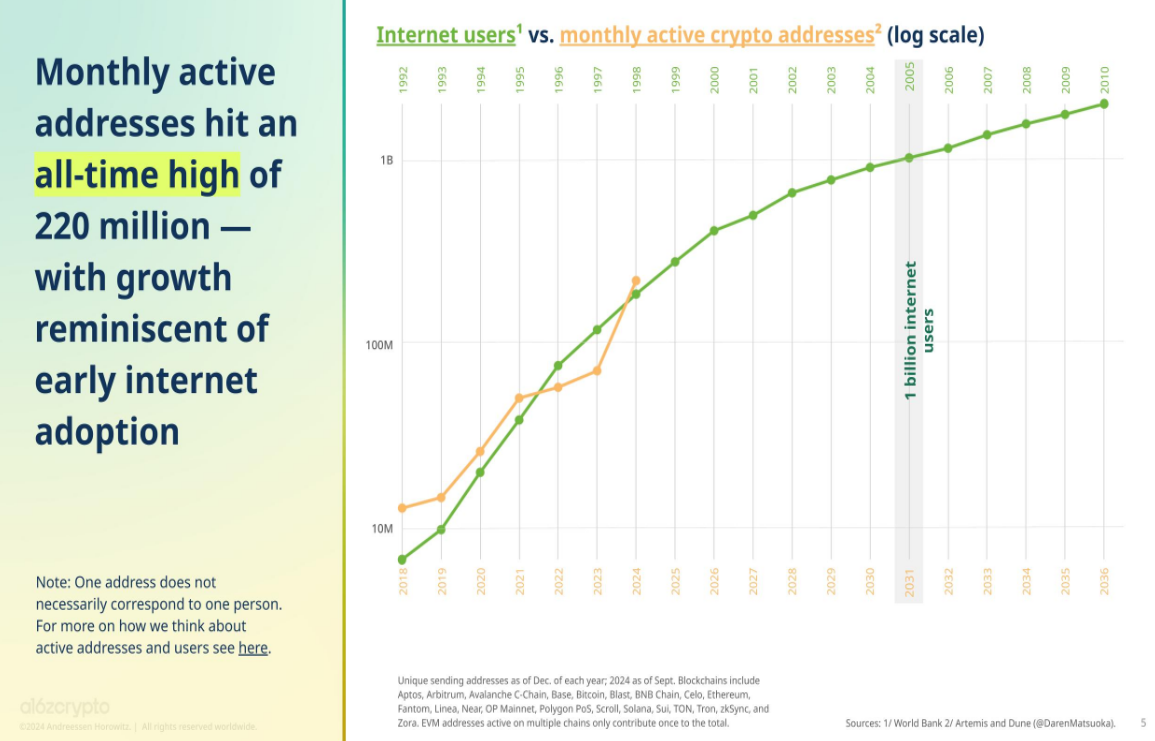
The surge in activity is primarily attributed to Solana, which accounts for about 100 million active addresses. This is followed by NEAR (31 million active addresses), Coinbase's popular L2 network Base (22 million), Tron (14 million), and Bitcoin (11 million). Among Ethereum Virtual Machine (EVM) chains, the second highest activity after Base is the BNB chain (10 million), followed by Ethereum (6 million). (Note: To calculate the total of 220 million, addresses on EVM chains were deduplicated by public key.)
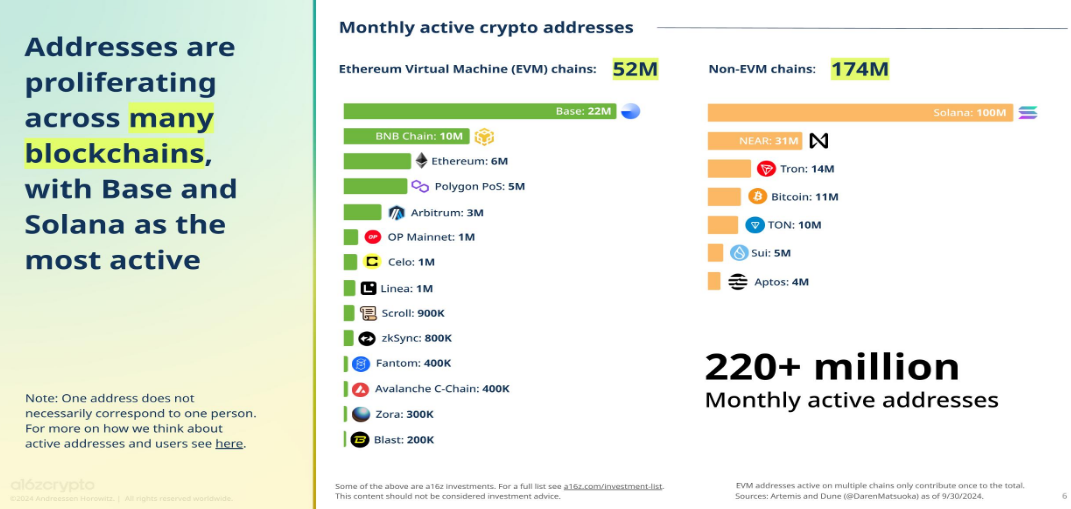
These trends are also reflected in our Builder Vitality Dashboard. Overall, Solana has seen the largest change in market share of builder interest. Specifically, the total share of founders indicating they are building or interested in building on Solana has increased from 5.1% last year to 11.2% this year. Following Solana is Base, with its total share increasing from 7.8% last year to 10.7%, and then Bitcoin, with its total share rising from 2.6% last year to 4.2%.
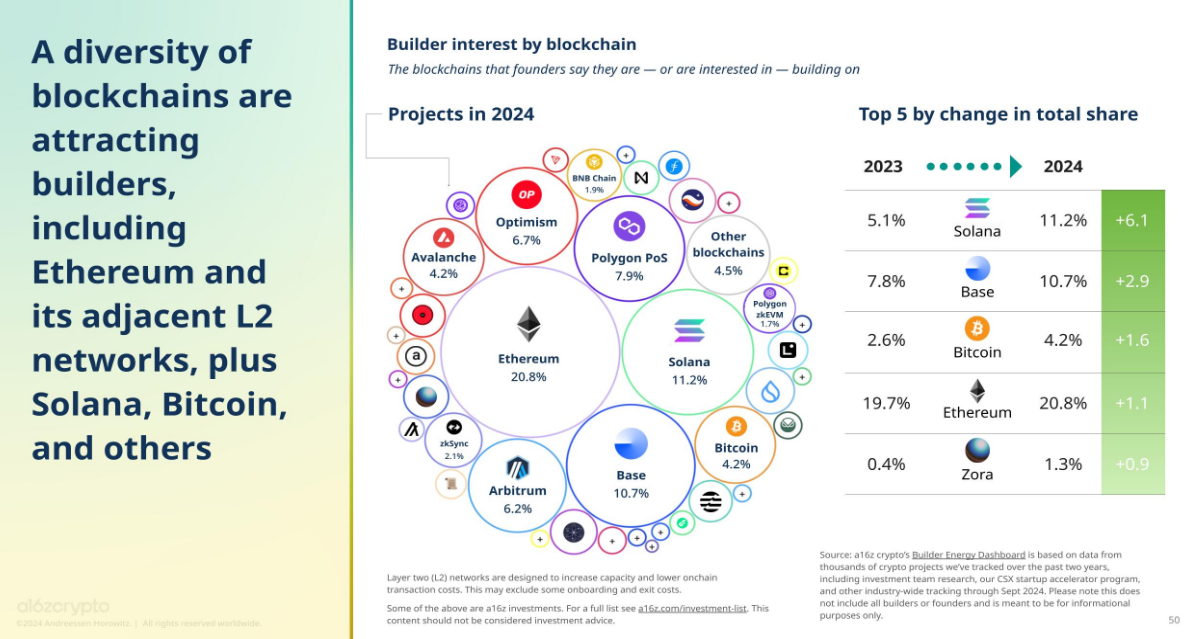
In absolute numbers, Ethereum still attracts the largest share of builder interest, reaching 20.8%, followed by Solana and Base. This is followed by Polygon (7.9%), Optimism (6.7%), Arbitrum (6.2%), Avalanche (4.2%), and Bitcoin (4.2%).
Meanwhile, in June 2024, the number of monthly active mobile wallet users reached a historic high of 29 million. Although the U.S. accounts for the largest share of monthly mobile wallet users (12%), its share of the total global mobile wallet users has declined in recent years as cryptocurrency has gained popularity worldwide, and more projects have sought compliance by excluding U.S. users through geofencing.
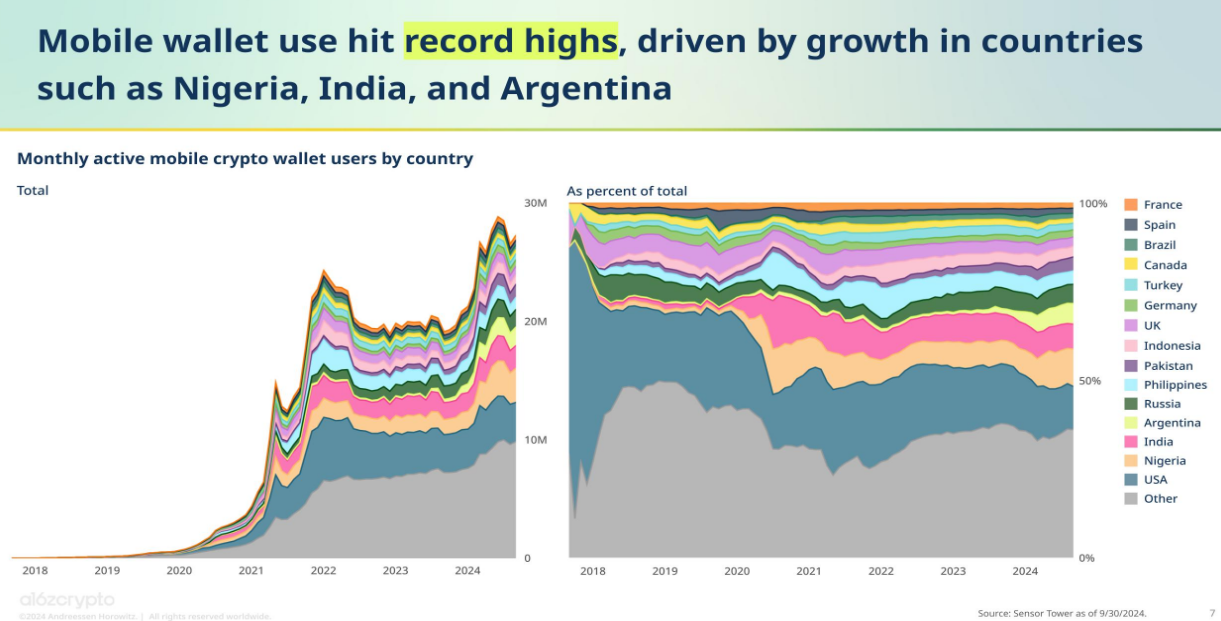
The influence of cryptocurrency continues to expand overseas. Following the U.S., the countries with the most mobile wallet users include Nigeria (which is committed to providing regulatory transparency, including through regulatory incubation projects, and has seen significant growth in consumer use areas such as bill payments and retail shopping), India (with its large population and mobile penetration), and Argentina (where many residents have turned to cryptocurrency—especially stablecoins—amid currency devaluation).
While the number of active addresses and monthly mobile wallet users is easy to measure, measuring the actual number of active cryptocurrency users is much more complex. However, by combining various methods, we estimate that there are approximately 30 million to 60 million active cryptocurrency users globally each month, accounting for 5% to 10% of the estimated 617 million cryptocurrency holders worldwide as of June 2024, according to Crypto.com. (For more details on our estimation methods, see here.)
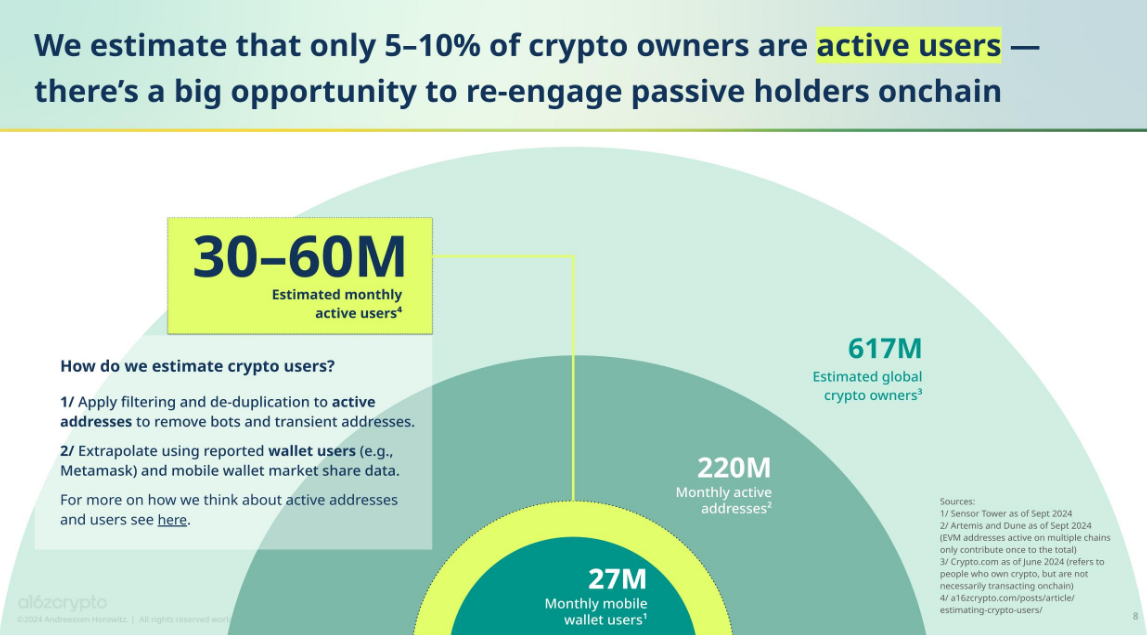
This discrepancy highlights the significant opportunity to attract—and re-attract—passive cryptocurrency holders. As major infrastructure improvements make new, attractive applications and consumer experiences possible, more dormant cryptocurrency holders may become active on-chain users.
2. Cryptocurrency has become an important political issue ahead of the U.S. elections
Cryptocurrency has broken into the national discourse of this election cycle.
As such, we measured the level of interest in cryptocurrency in swing states. The two key states expected to see the most intense competition in November—Pennsylvania and Wisconsin—ranked fourth and fifth, respectively, in terms of cryptocurrency search interest since the last election in 2020, according to Google Trends search volume. Michigan ranked eighth, with a noticeable increase in search interest, while Georgia remained unchanged. Meanwhile, interest in Arizona and Nevada has declined since 2020.
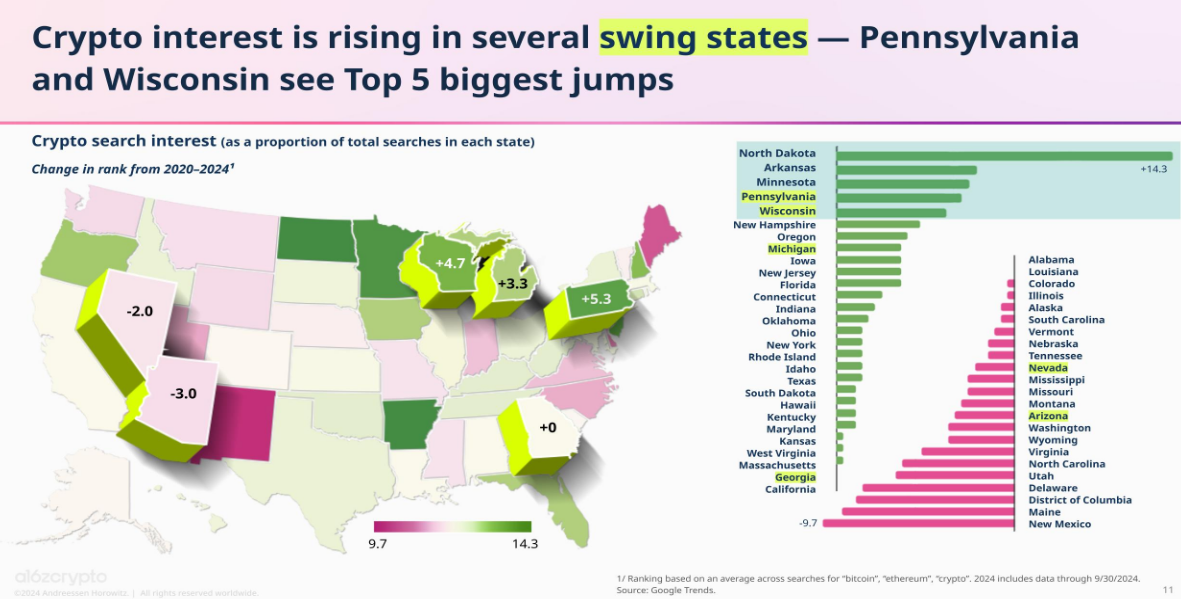
One factor that may have sparked increased interest in cryptocurrency this year is the launch of Bitcoin and Ethereum exchange-traded products (ETPs). With the emergence of these ETPs, which can broaden investor participation, the number of Americans holding cryptocurrency is expected to increase. The total assets of Bitcoin and Ethereum ETPs have reached $65 billion. (Note: Although these products are commonly referred to as ETFs, they are actually registered as ETPs, using the SEC's S-1 form, indicating that their underlying portfolios do not consist of securities.)
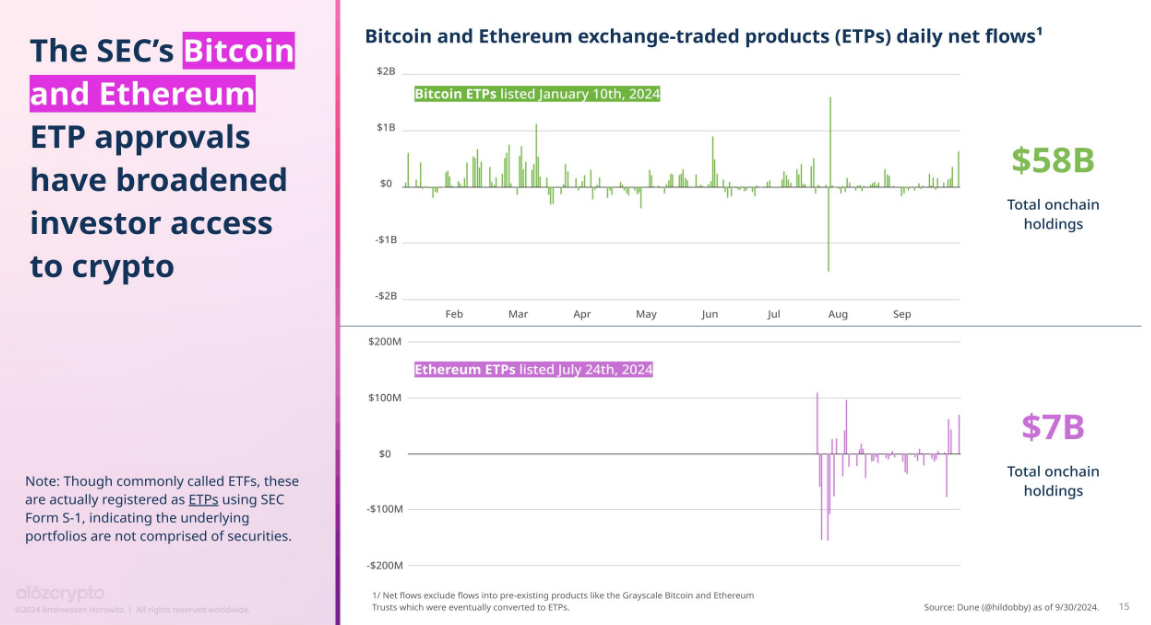
The approval of ETPs by the U.S. Securities and Exchange Commission (SEC) marks a significant advancement in cryptocurrency policy. Regardless of which party wins the election in November, many politicians expect momentum to further increase with the passage of bipartisan-supported cryptocurrency legislation. An increasing number of policymakers and politicians across both parties are taking a positive stance on cryptocurrency.
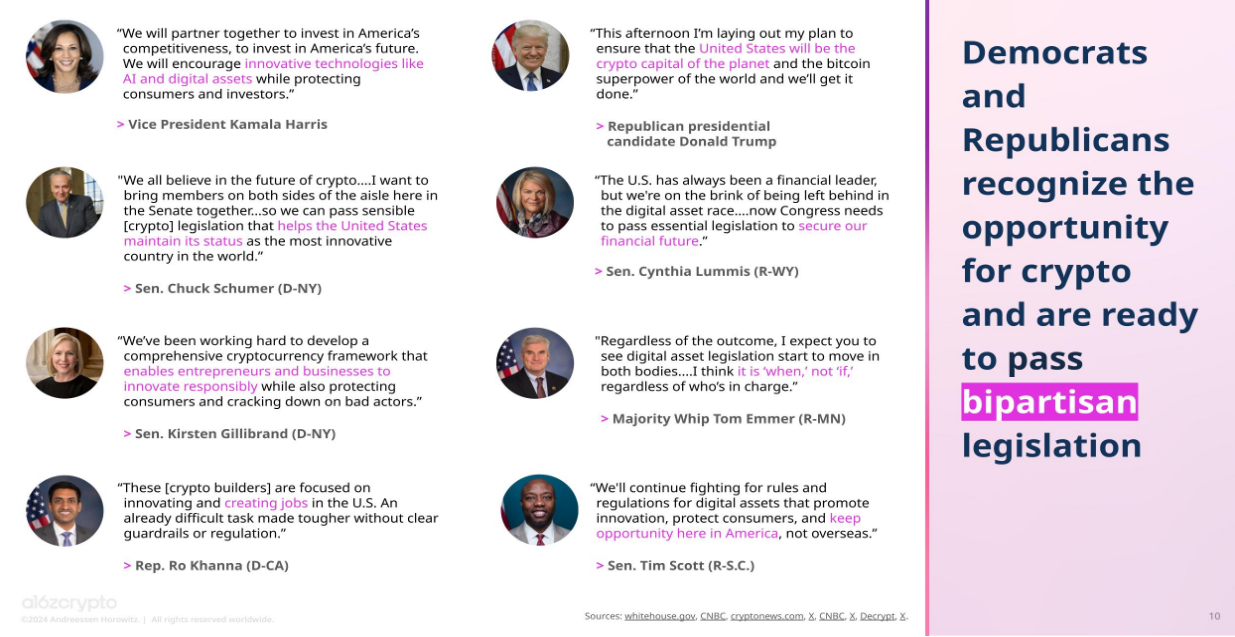
This year, the cryptocurrency industry has also driven other important changes at the policy level. At the federal level, the U.S. House of Representatives passed the "Financial Innovation and Technology Act of the 21st Century" (FIT21) with bipartisan support, with 208 Republicans and 71 Democrats voting in favor. If the bill passes Senate review and approval, it could provide much-needed regulatory clarity for cryptocurrency entrepreneurs.
Equally important, at the state level, Wyoming has passed the "Decentralized Non-Profit Corporation Act" (DUNA), which provides legal recognition for decentralized autonomous organizations (DAOs) and allows blockchain networks to operate legally without compromising the principles of decentralization.
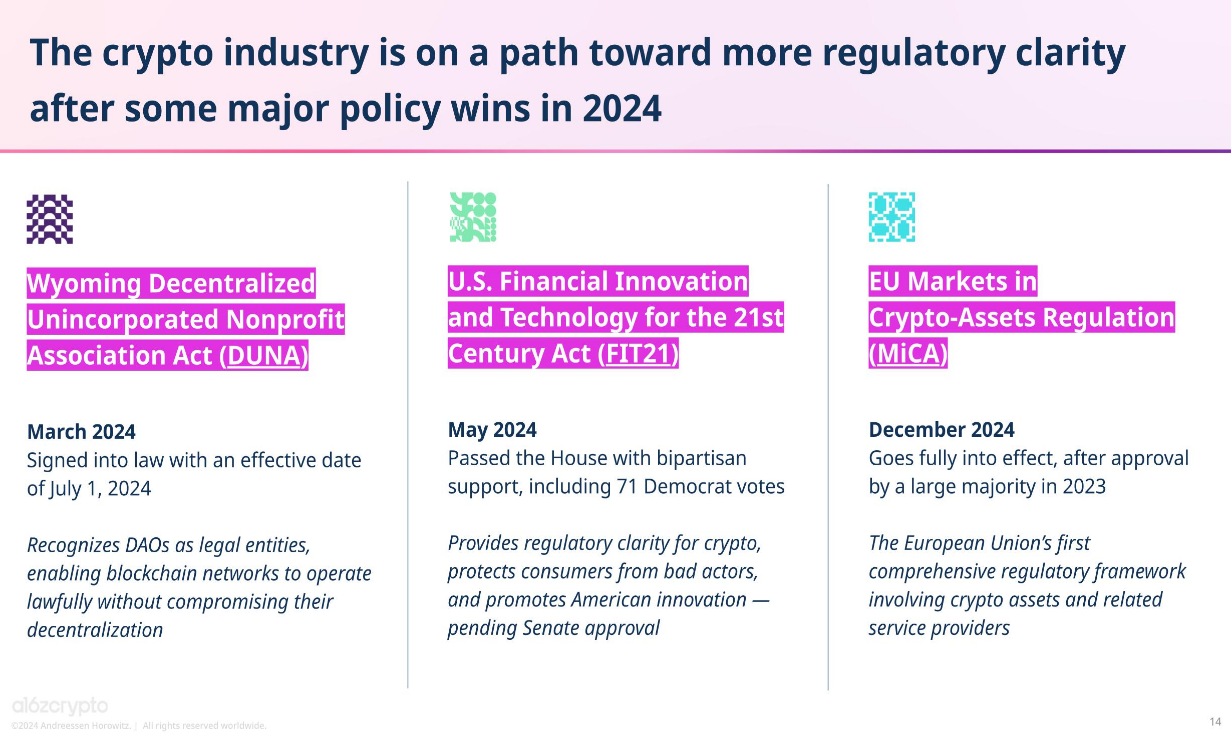
The EU and the UK have been the most proactive in engaging with the public on cryptocurrency policy and regulatory issues. Compared to agencies like the U.S. SEC, several European institutions have issued more requests for comments. Meanwhile, the EU's "Markets in Crypto-Assets" (MiCA) regulation is the first comprehensive legislative framework for cryptocurrency-related policies, expected to come into full effect by the end of the year.
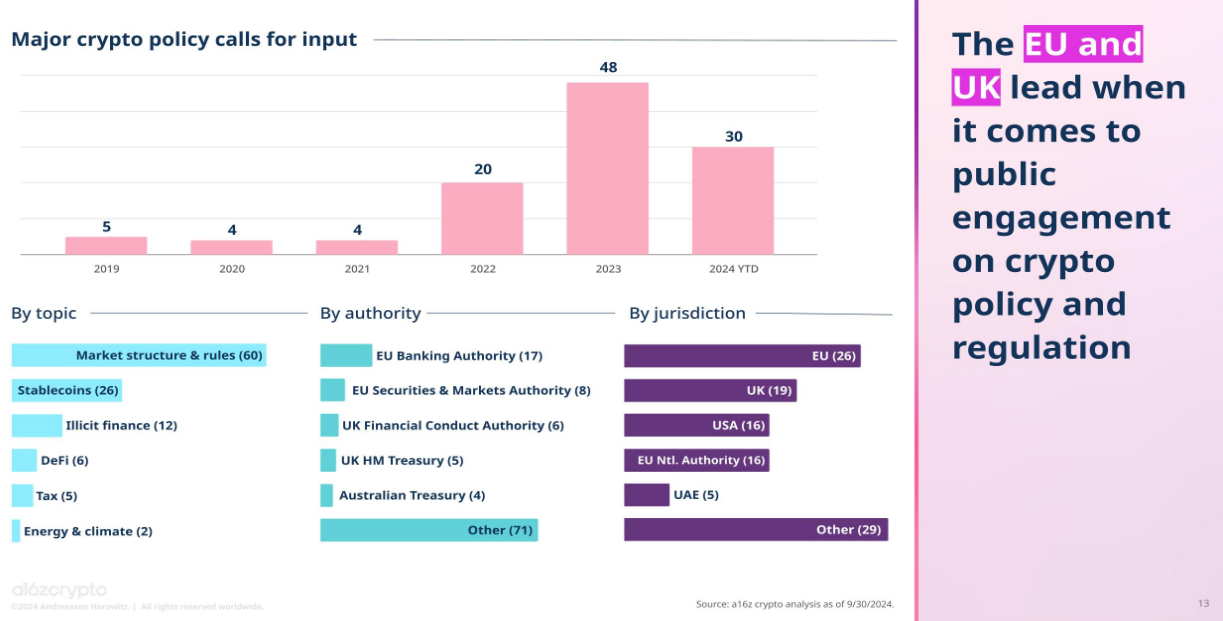
Stablecoins—now one of the most popular cryptocurrency products—are a major topic of policy discussion, with several related bills currently under discussion in Congress. In the U.S., one driving factor is the recognition that stablecoins can enhance the dollar's position globally, even as the dollar's status as the world's reserve currency is declining. Currently, over 99% of stablecoins are pegged to the dollar, far exceeding the second-largest pegged currency, the euro, which accounts for only 0.20%.
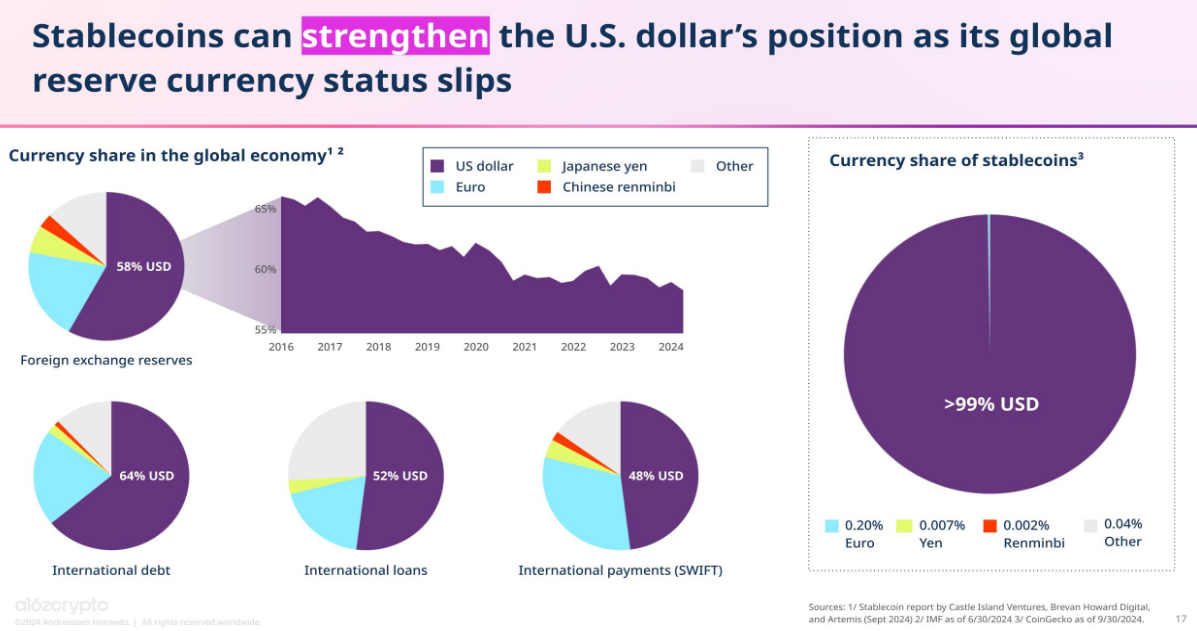
In addition to enhancing the global influence of the U.S. dollar, stablecoins may also strengthen the country's financial foundation domestically. Despite having only a ten-year history, they have already risen to become one of the top 20 holders of U.S. debt, surpassing countries like Germany.
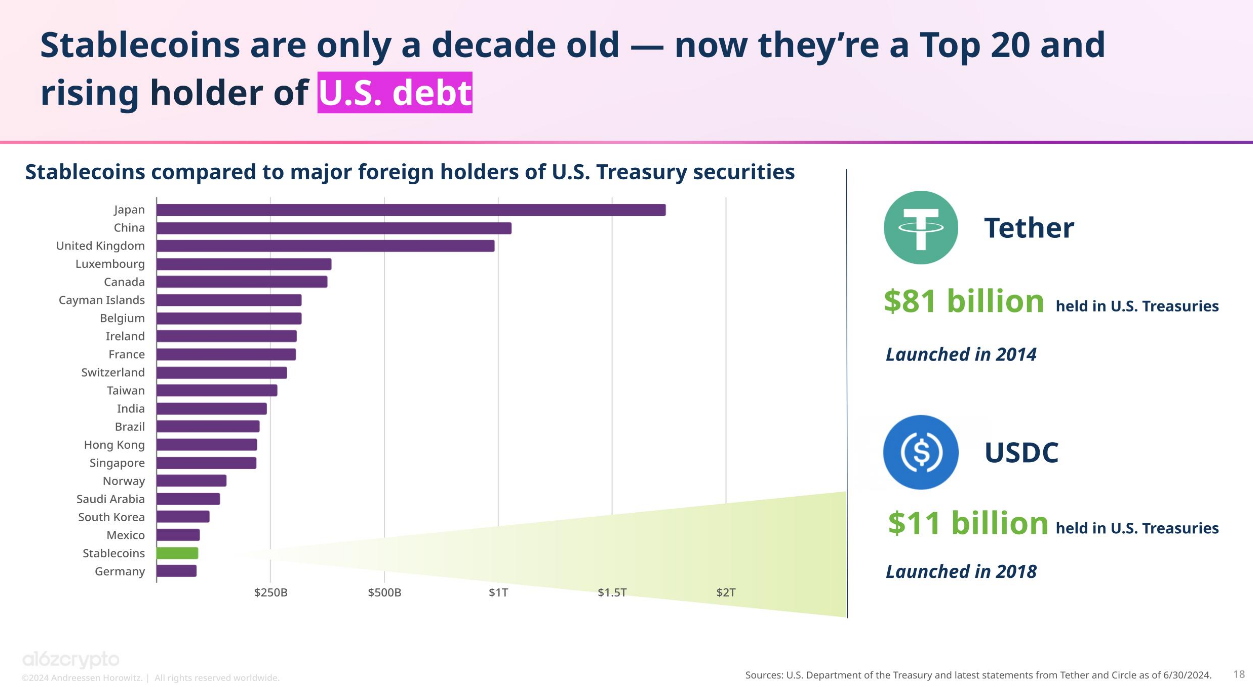
While some countries are exploring Central Bank Digital Currencies (CBDCs), the opportunity for stablecoins in the U.S. has matured and is ready to be seized. Against this backdrop of discussions, and with many important political figures now weighing in on cryptocurrency, we expect more countries to begin seriously formulating and refining their own cryptocurrency policies and strategies.
3. Stablecoins have found product-market fit
By enabling fast, low-cost global payments, stablecoins have become one of the most obvious "killer applications" in cryptocurrency. As New York Democratic Congressman Ritchie Torres wrote in a September op-ed for the New York Daily News: "The proliferation of dollar-pegged stablecoins—thanks to the ubiquity of smartphones and blockchain encryption technology—could become the largest financial empowerment experiment in human history."
Major scaling upgrades have significantly reduced the costs of cryptocurrency transactions, including those involving stablecoins, with costs dropping by over 99% in some cases. On the Ethereum network, the average gas fee for transactions involving USDC (a popular dollar-pegged stablecoin) this month was $1, a significant decrease from an average of $12 in 2021. On Coinbase's popular L2 network Base, the cost of sending USDC averages less than one cent. (Note that these figures may not include some onboarding and offboarding costs.)
The difference is particularly striking when compared to the average cost of international wire transfers, which is $44.
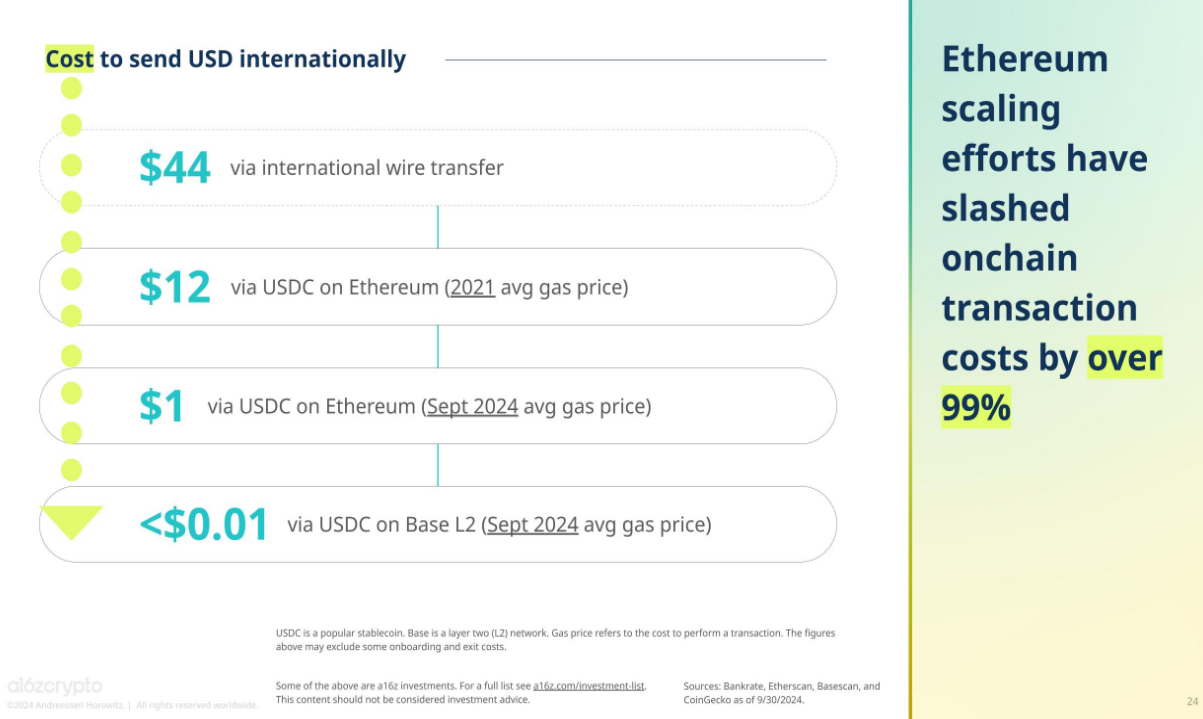
Stablecoins make value transfer more convenient. In the second quarter of 2024 (ending June 30), the transaction volume of stablecoins reached $8.5 trillion, completing 1.1 billion transactions. The transaction volume of stablecoins is more than double that of Visa, which had a transaction volume of $3.9 trillion during the same period. Stablecoins have entered discussions alongside well-known and entrenched payment services like Visa, PayPal, ACH, and Fedwire, which undoubtedly serves as a significant testament to their practicality.

Stablecoins are not just a passing trend. When comparing stablecoin activity with the volatility cycles of the cryptocurrency market, there seems to be no correlation. In fact, even as spot cryptocurrency trading volumes have declined, the number of monthly addresses sending stablecoins continues to increase. In other words, people seem to be using stablecoins for more than just trading.
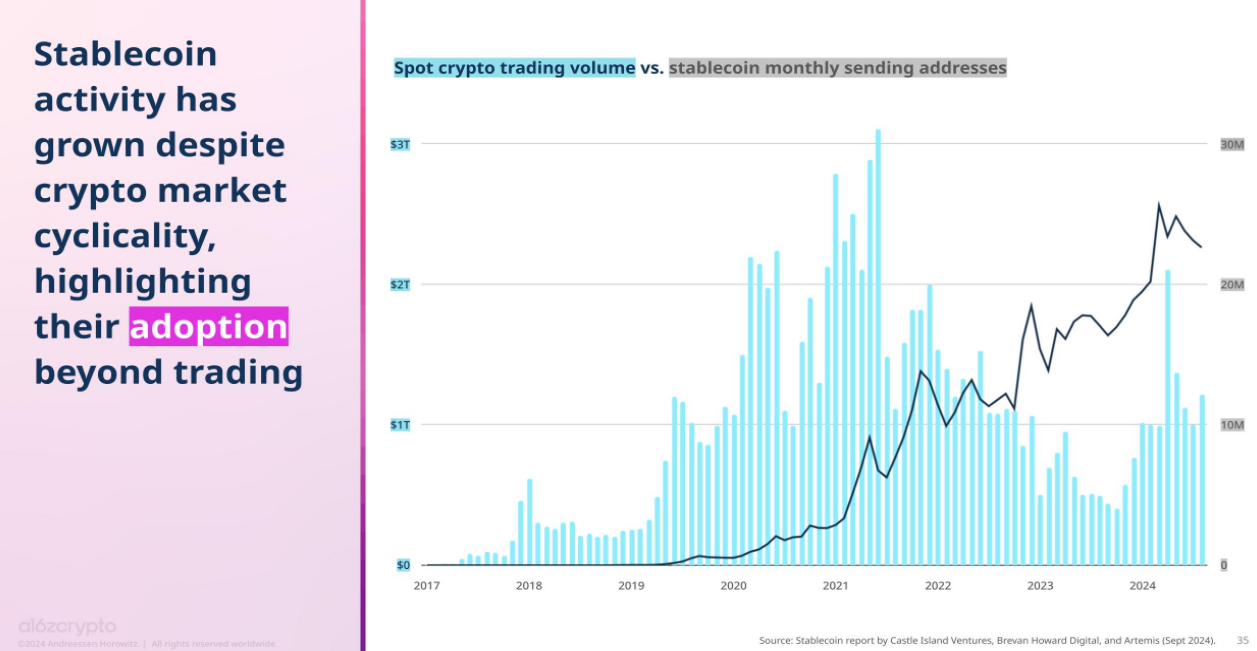
All of this activity is reflected in usage statistics. Stablecoins account for nearly one-third of daily cryptocurrency usage at 32%, second only to decentralized finance (DeFi) at 34%, measured by the share of daily active addresses. The remaining cryptocurrency usage is distributed across infrastructure (such as bridging, oracles, maximum extractable value, account abstraction, etc.), token transfers, and other areas, including emerging applications like gaming, NFTs, and social networks.
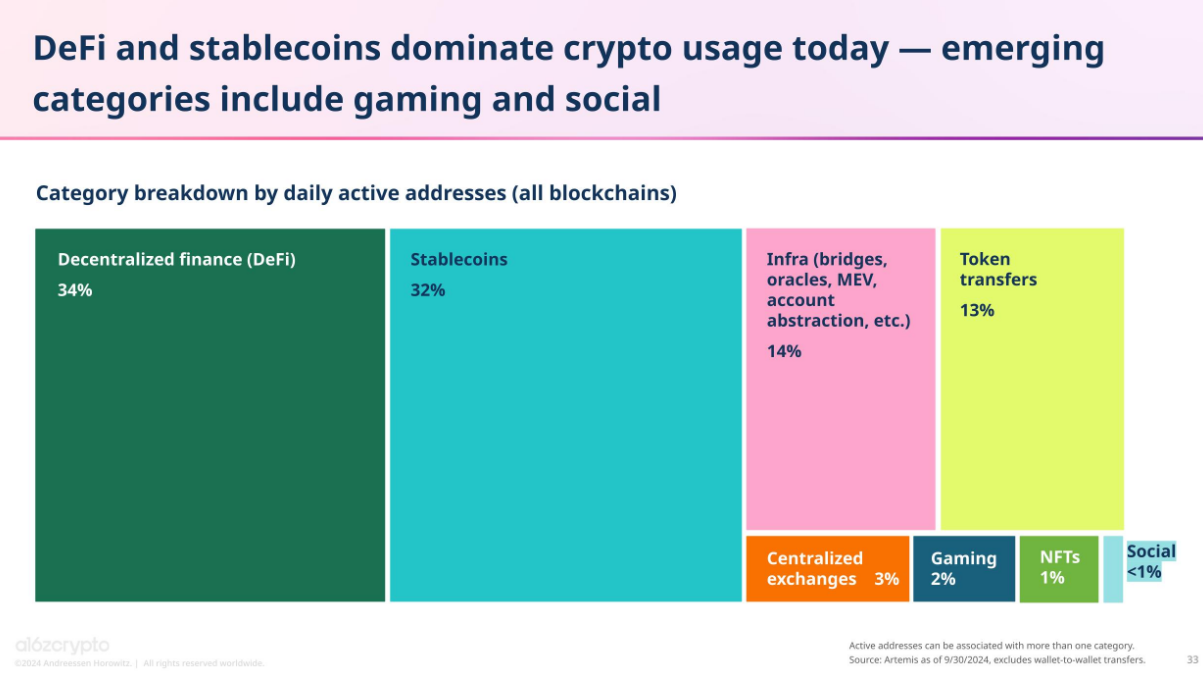
4. Infrastructure improvements have increased capacity and significantly reduced transaction costs
The popularity and ease of use of stablecoins are partly due to the infrastructure advancements behind them. First, the processing capacity of blockchains is increasing. Thanks to the rise of Ethereum L2 networks and other high-throughput blockchains, the number of transactions processed by blockchains per second has increased more than 50 times compared to four years ago.
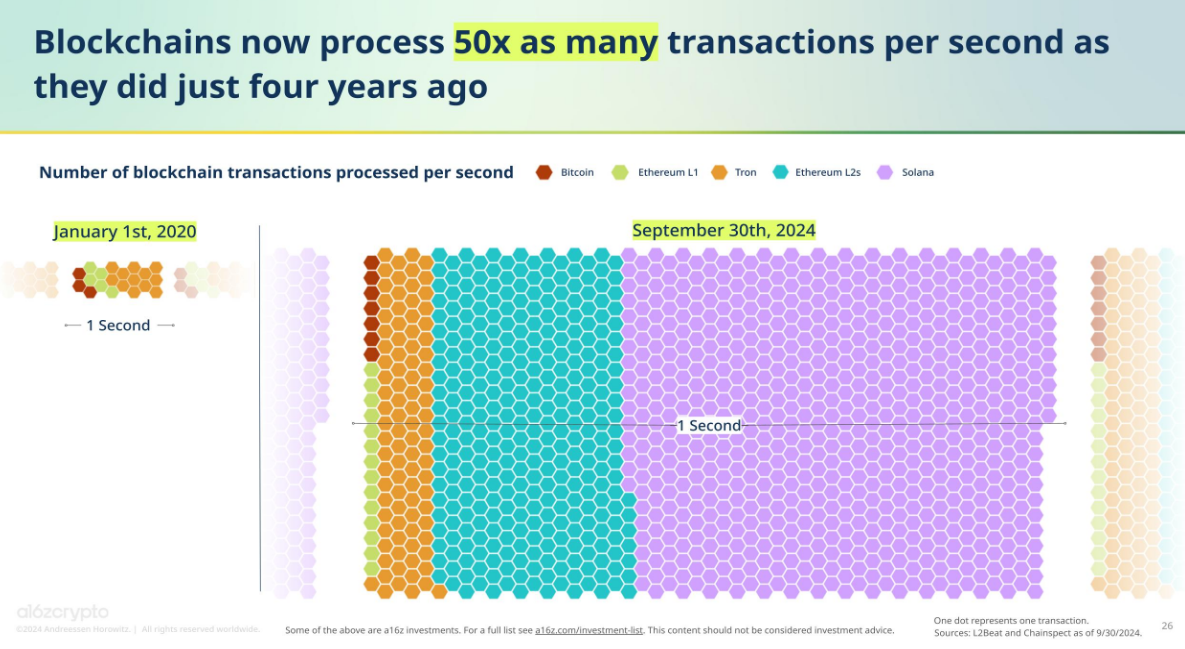
More remarkably, Ethereum's biggest upgrade this year—"Dencun," also known as "protodanksharding" or EIP-4844—significantly reduced fees on L2 networks after its implementation in March 2024. Since then, despite the ETH-denominated value on L2 continuing to rise, the payment fees on L2 in Ethereum have sharply decreased. In other words, blockchain networks have not only become more popular but also more efficient.
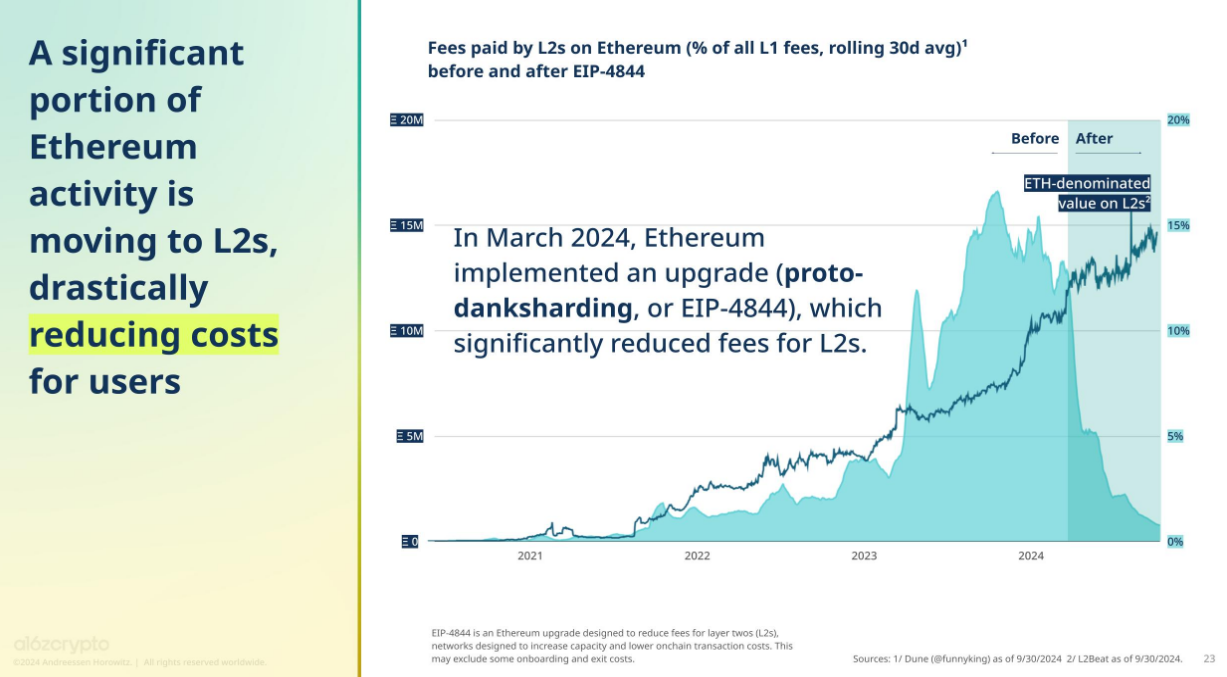
Zero-knowledge proofs (ZK proofs) are similarly positioned, as this technology is crucial for blockchain scalability, privacy, and interoperability. Even though the monthly costs for verifying ZK proofs on Ethereum have decreased, the ETH-denominated value on ZK aggregation chains has increased. In other words, ZK proofs have become cheaper while also becoming more popular. (The term "zero-knowledge" here refers broadly to cryptographic techniques that can succinctly prove that computations transferred to aggregation chain networks have been executed correctly.)
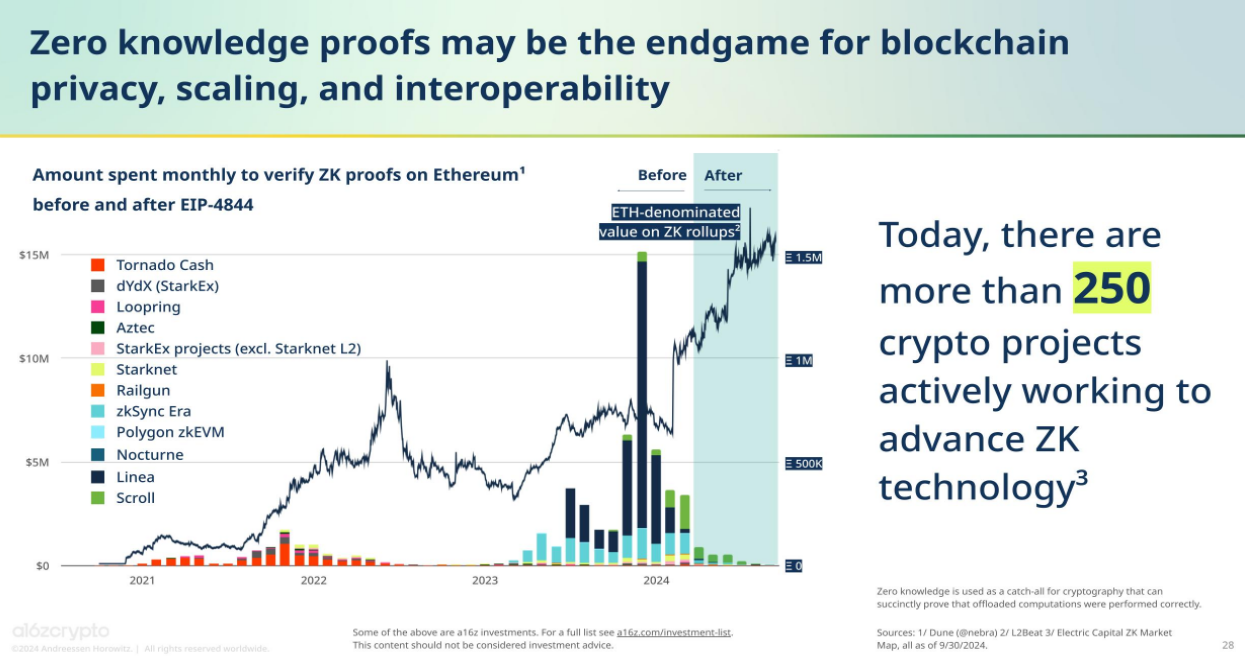
Zero-knowledge technology holds great promise as it opens up new avenues for developers to create cheap and verifiable blockchain computations. However, ZK-based virtual machines (zkVMs) still have a long way to go in terms of performance and have yet to catch up with traditional computers—this is a humbling observation.
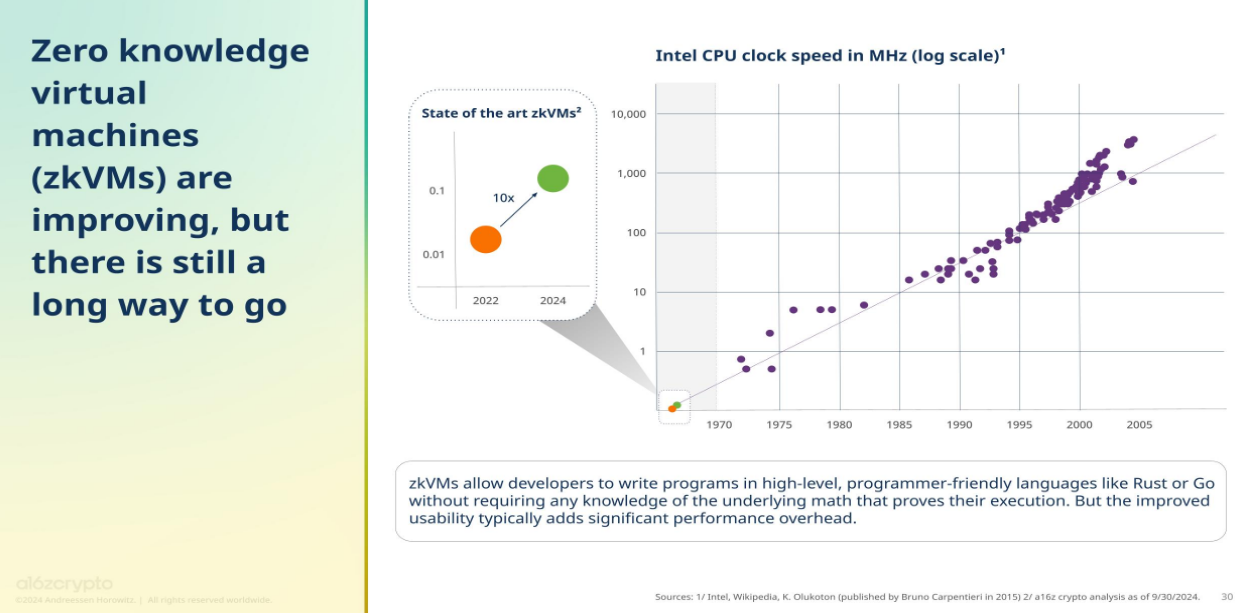
With all these infrastructure improvements, it’s easy to understand why blockchain infrastructure remains one of the most popular areas for builders, and why L2 networks have become one of the top five hottest builder subcategories we track.
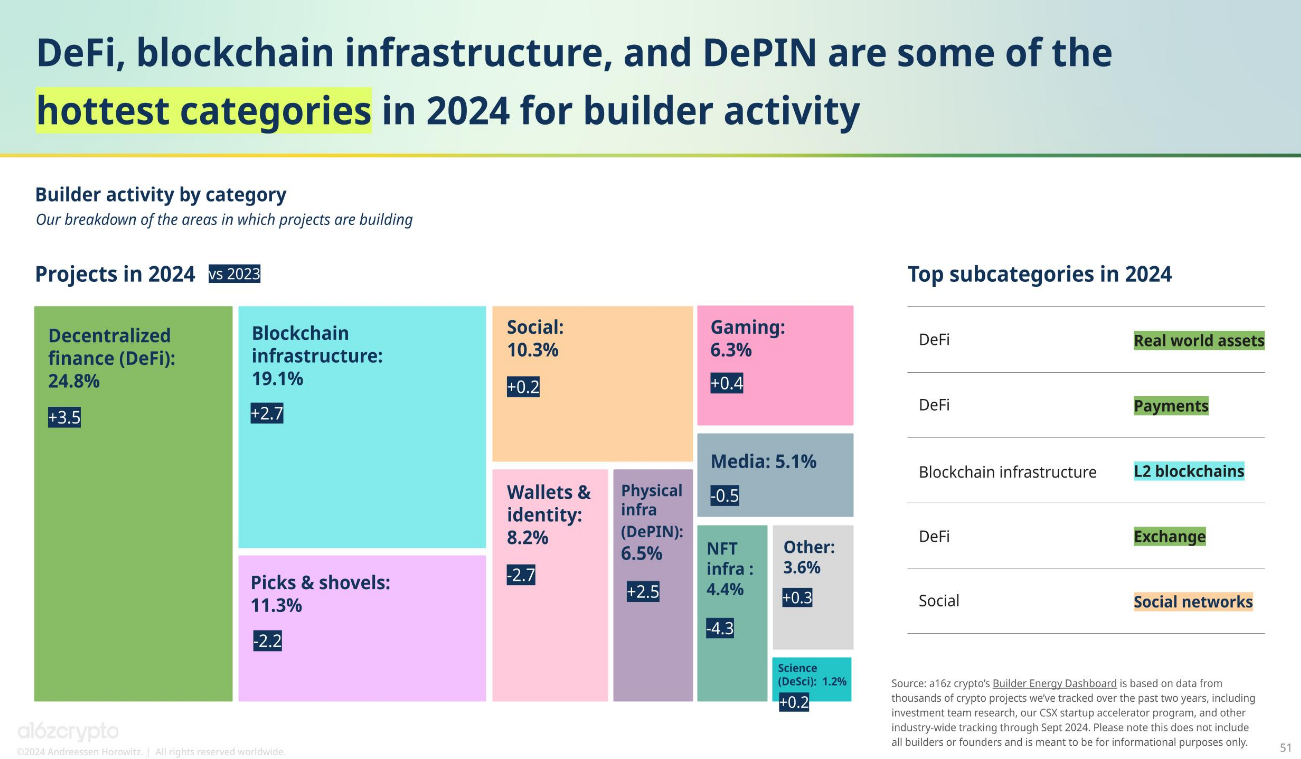
5. Decentralized Finance (DeFi) Remains Popular—and is Growing
The only area attracting builders more than blockchain infrastructure is Decentralized Finance (DeFi) (which also accounts for the highest cryptocurrency usage among daily active addresses at 34%). Since the rise of DeFi in the summer of 2020, decentralized exchanges (DEXs) have captured 10% of spot cryptocurrency trading activity, whereas all of this trading occurred on centralized exchanges just four years ago.
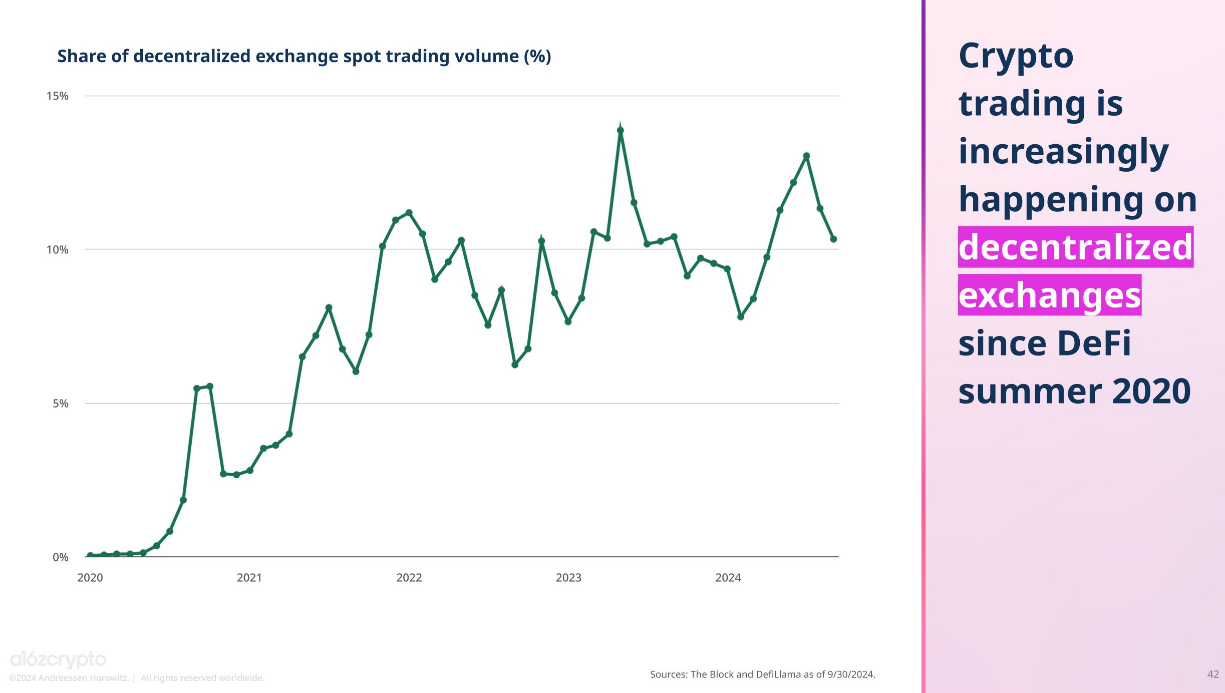
Currently, over $169 billion is locked in thousands of DeFi protocols. Some major DeFi subcategories include staking and lending.
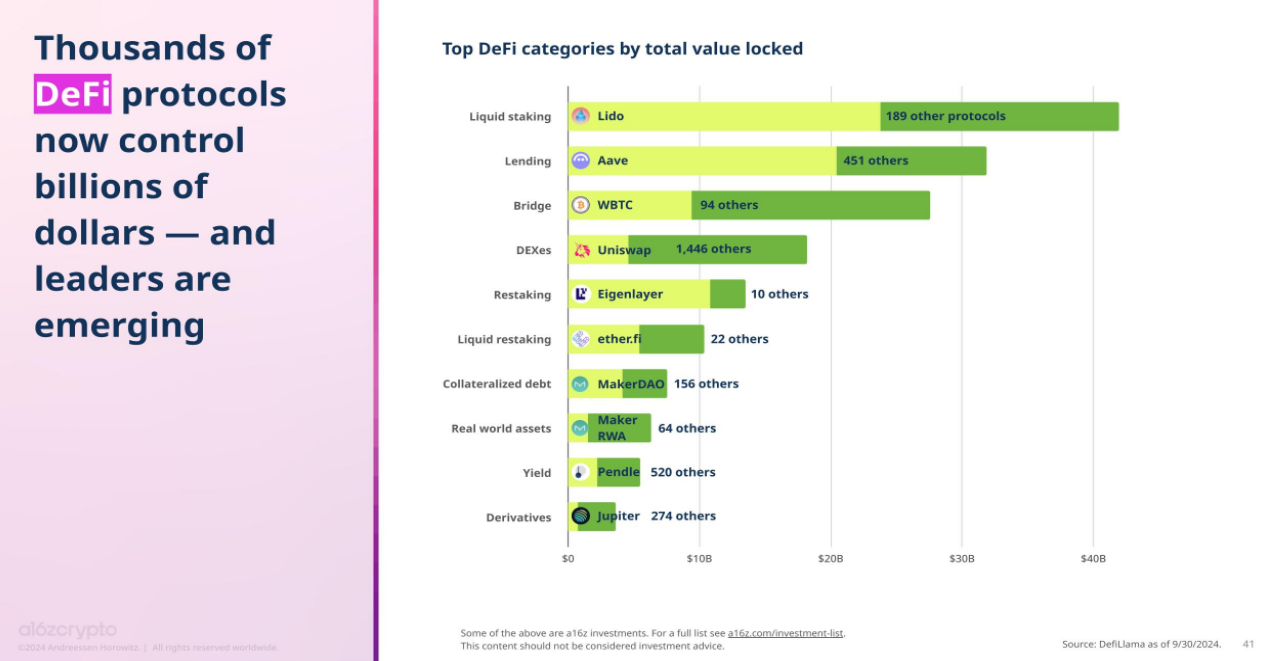
It has been just over two years since Ethereum completed its transition to Proof of Stake (PoS), a change that significantly reduced the network's energy consumption and environmental footprint. Since then, the share of staked Ethereum has risen from 11% two years ago to 29%, greatly enhancing the network's security.
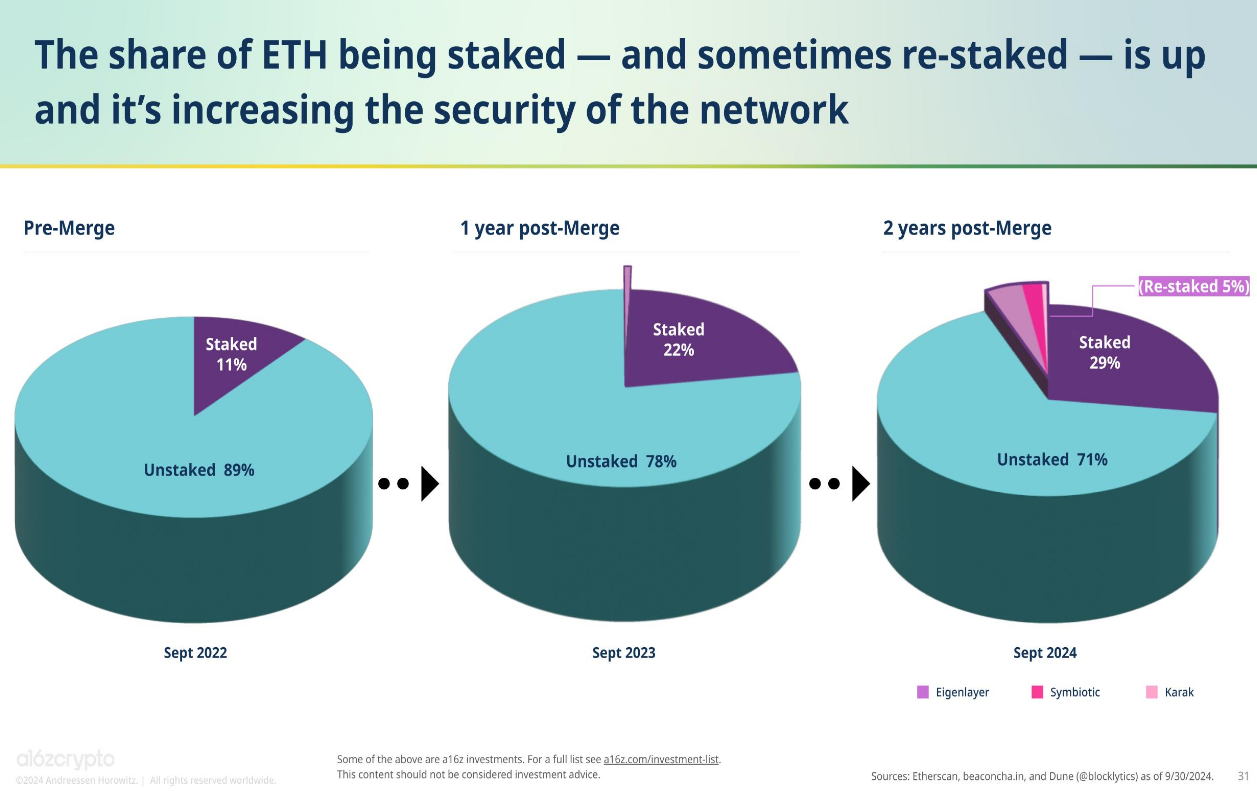
Although still in its early stages, DeFi offers a hopeful alternative to the increasingly severe trends of centralization and power concentration in the U.S. financial system. In the U.S., the number of banks has decreased by two-thirds since 1990, with a few large banks dominating an ever-smaller share of assets.
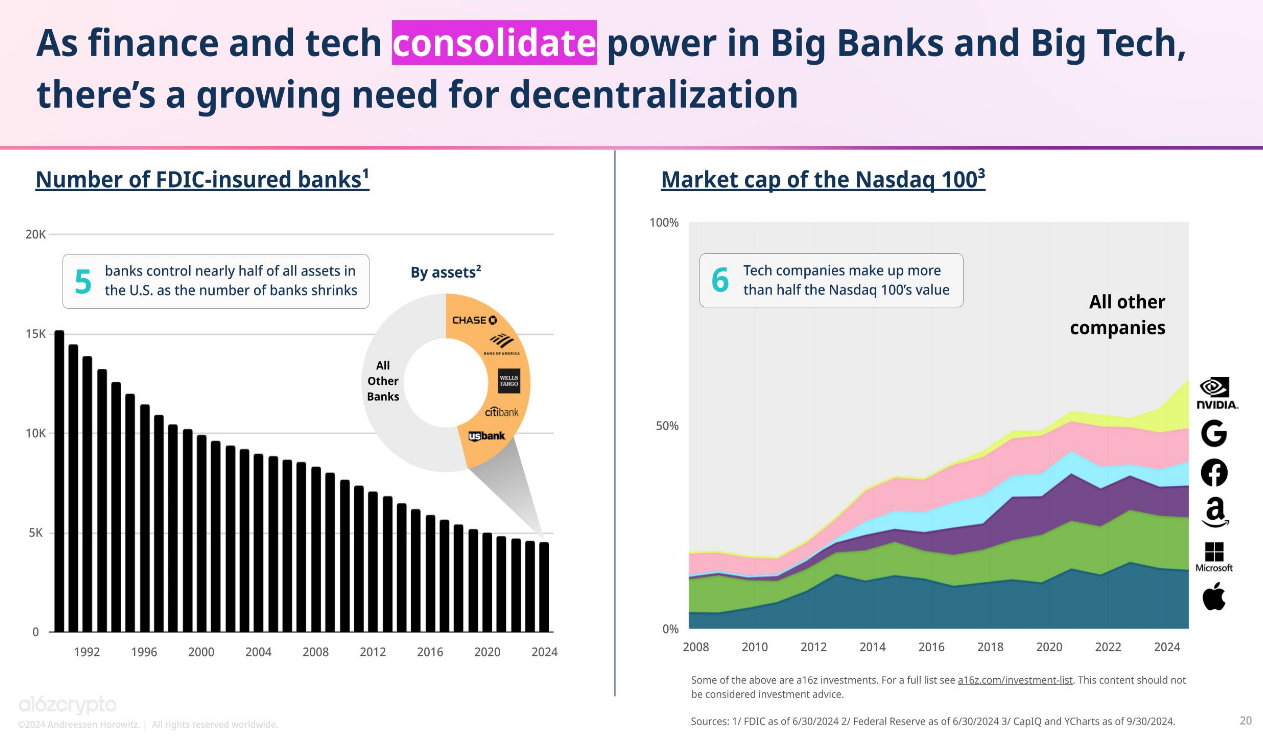
6. Cryptocurrency May Address Some Urgent Challenges in Artificial Intelligence
Artificial Intelligence (AI) is one of the hottest trends this year, garnering widespread attention not only in the tech sector but also in the cryptocurrency space.
AI is one of the most discussed trends in the crypto community on social media. Perhaps more surprisingly, there is a significant overlap between visitors to chatgpt.com and those visiting top crypto websites, indicating a close connection between cryptocurrency and AI users.
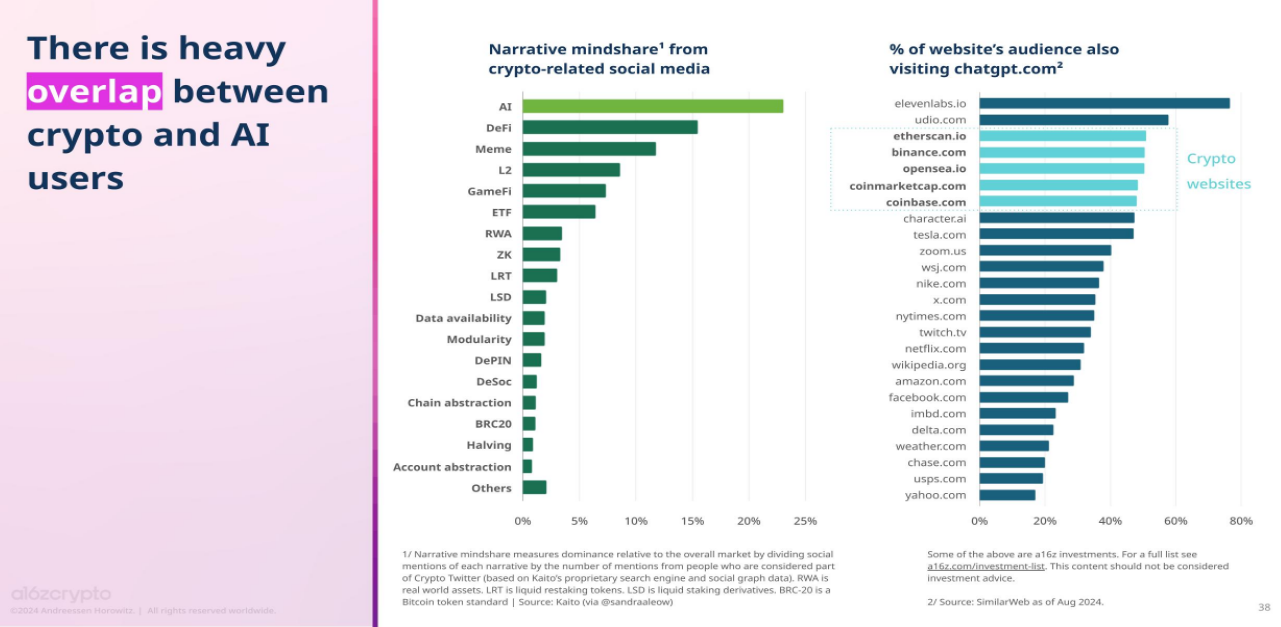
Cryptocurrency builders also have a close connection with AI. According to our Builder Energy dashboard, about one-third of crypto projects (34%) report that they are using AI, a rise from 27% last year, regardless of the category they are building in. The most popular category for applying AI technology is blockchain infrastructure projects.
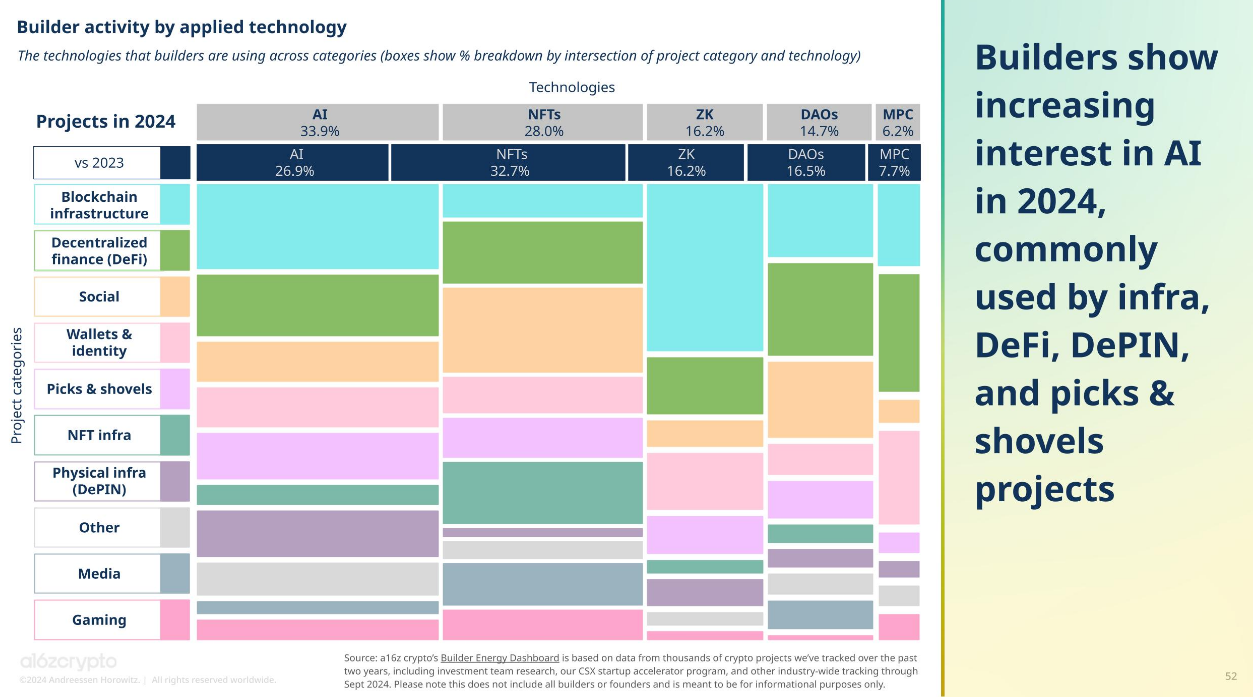
Given that the cost of training cutting-edge AI models has quadrupled each year over the past decade, we believe that AI may tend to increase the centralization of power on the internet. If left unchecked, only the largest tech companies may have the resources to train the latest AI models.
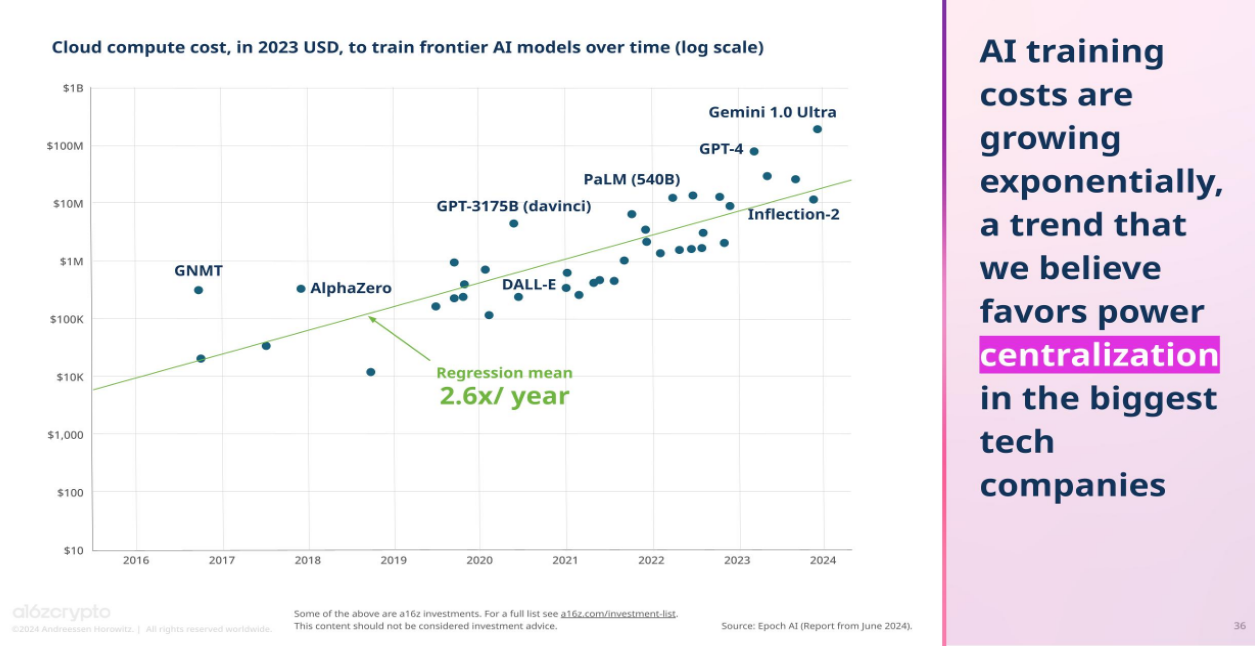
The challenges associated with AI centralization are almost entirely opposite to the decentralized opportunities presented by blockchain networks. Crypto projects are already attempting to address some of these challenges, including Gensyn (democratizing access to AI computing resources), Story (helping to compensate creators by tracking intellectual property), Near (running AI on open-source, user-owned protocols), and Starling Labs (helping to verify the authenticity and provenance of digital media), among others.
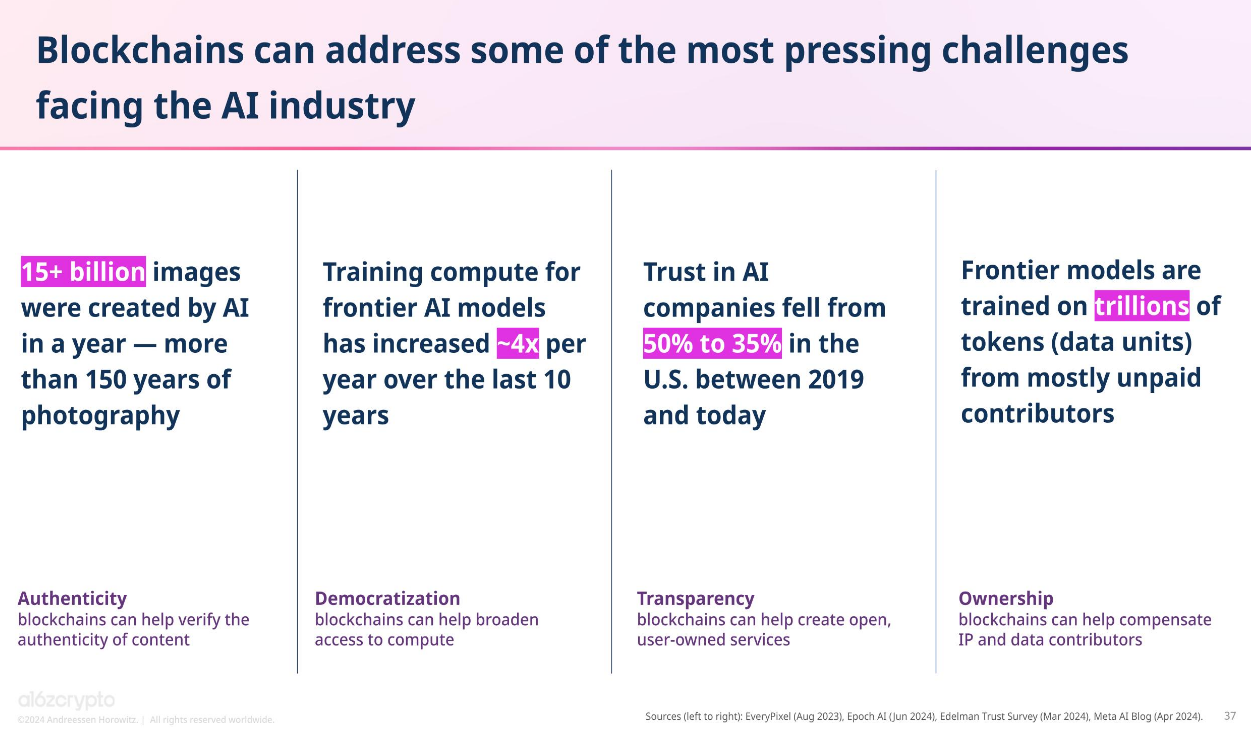
The intersection of crypto and AI may strengthen in the coming years.
7. More Scalable Infrastructure Unlocks New On-Chain Applications
As transaction costs decrease and blockchain capacity increases, many other potential crypto consumer applications become possible.
Take NFTs as an example. When cryptocurrency transaction costs were high a few years ago, people traded NFTs on secondary markets, with total trading volumes reaching billions of dollars. Since then, this activity has decreased, replaced by a new consumer behavior: minting low-cost NFT collections on social applications like Zora and Rodeo. This represents a significant shift in the NFT market, a change that was nearly unimaginable before transaction fees dropped dramatically.
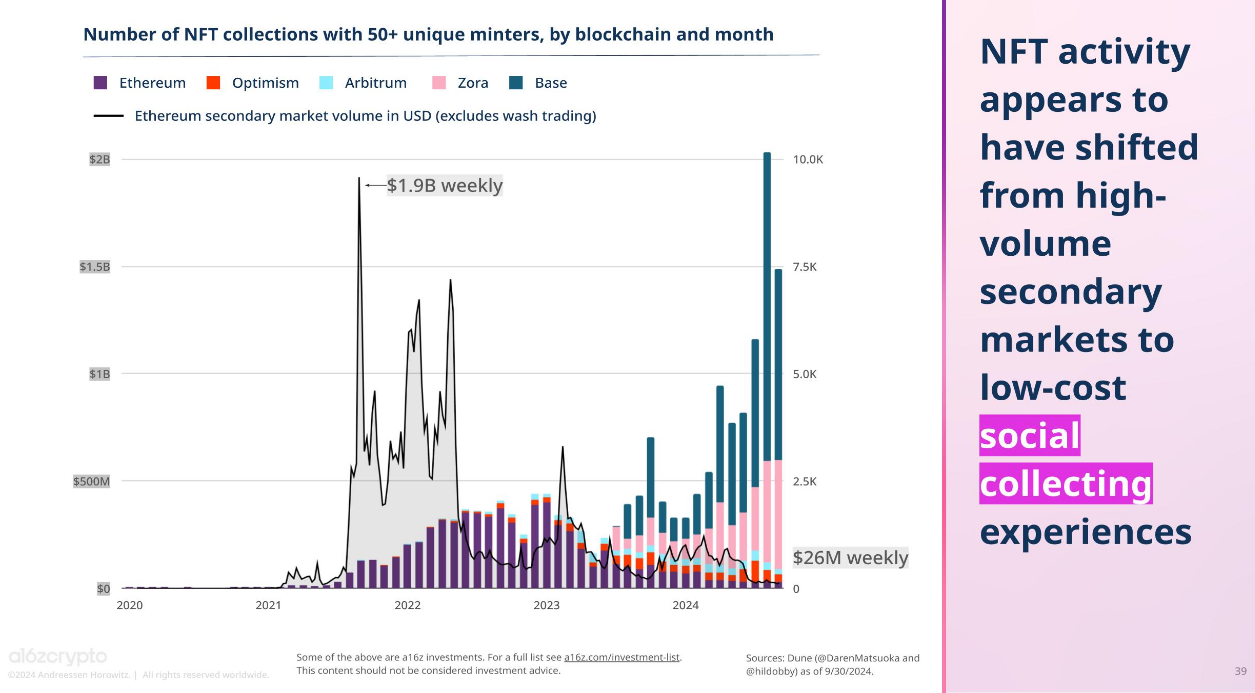
Social networks are another example. Although they currently account for only a small portion of daily on-chain activity, they are attracting a significant amount of builder activity: according to our Builder Energy dashboard, 10.3% of crypto projects in 2024 are related to social. In fact, projects related to social networks, such as those associated with Farcaster, are among the top five hottest builder subcategories this year.
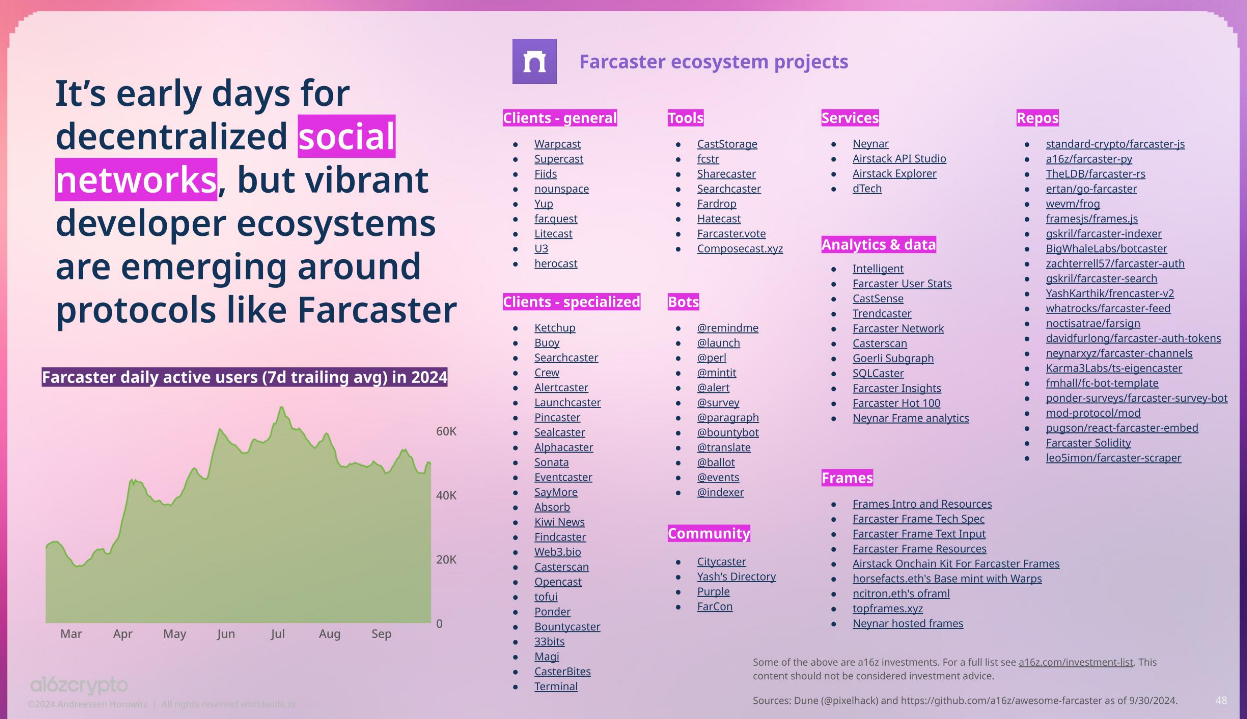
As builders and consumers explore more social experiences, on-chain gaming is pushing blockchain scalability to its limits. Games like "Pirate Nation," a role-playing game using Proof Of Play, consistently consume the most gas of all Ethereum rollups per second.
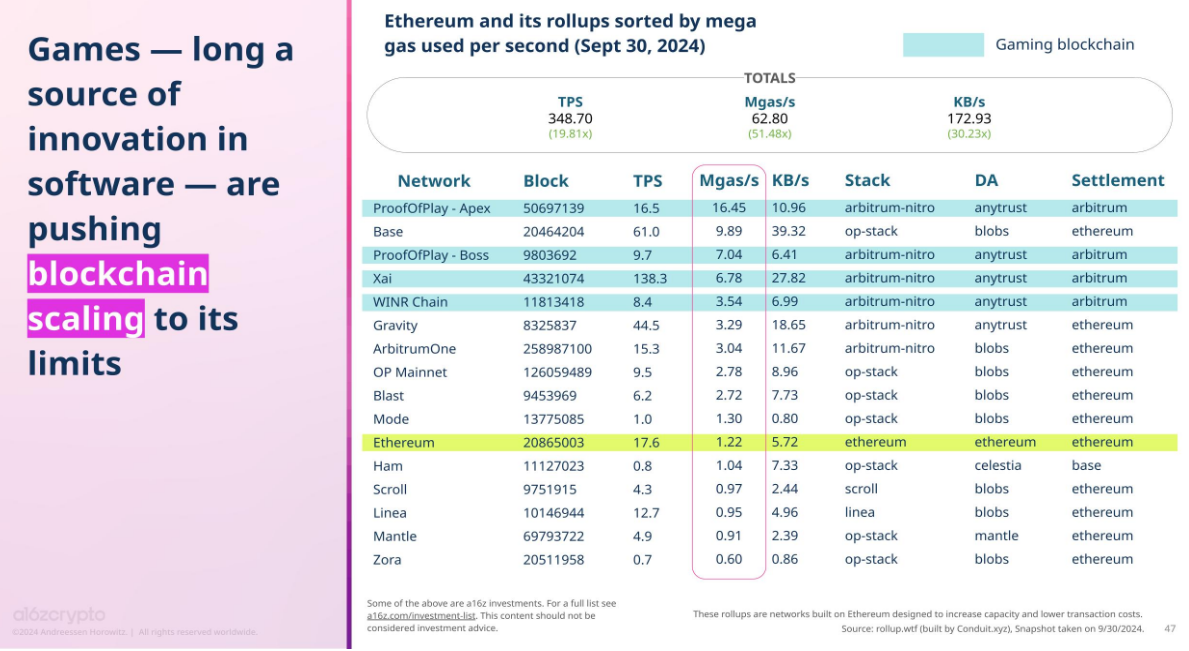
With the November elections approaching, crypto-based prediction markets are experiencing a surge—despite being illegal in the U.S.—overall momentum for prediction markets is gradually increasing. So much so that the non-crypto prediction market Kalshi won a preliminary ruling last month, and it is filing a federal lawsuit regarding election contracts. (Currently, registered trading platforms are allowed to offer traditional futures contracts based on elections.)
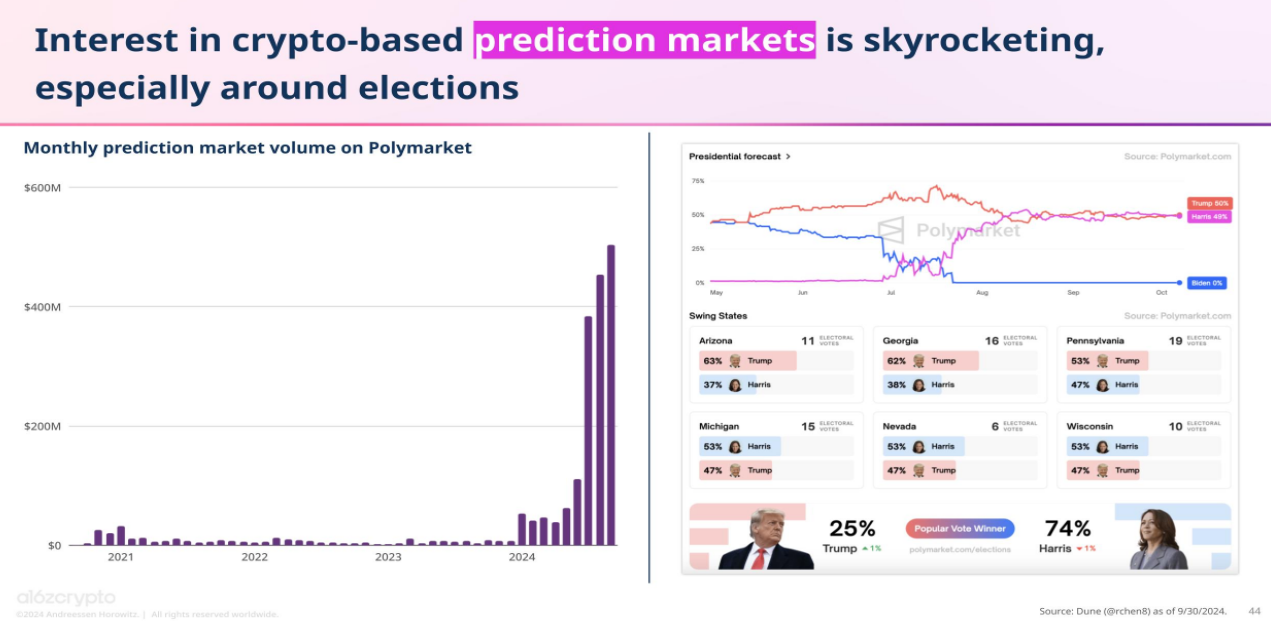
The dawn of new consumer behaviors is beginning to emerge. When blockchain infrastructure was cumbersome and transaction costs were high, these emerging experiences were nearly impossible to achieve. As blockchain technology continues to advance along the classic cost-performance curve, these applications are expected to thrive even more.
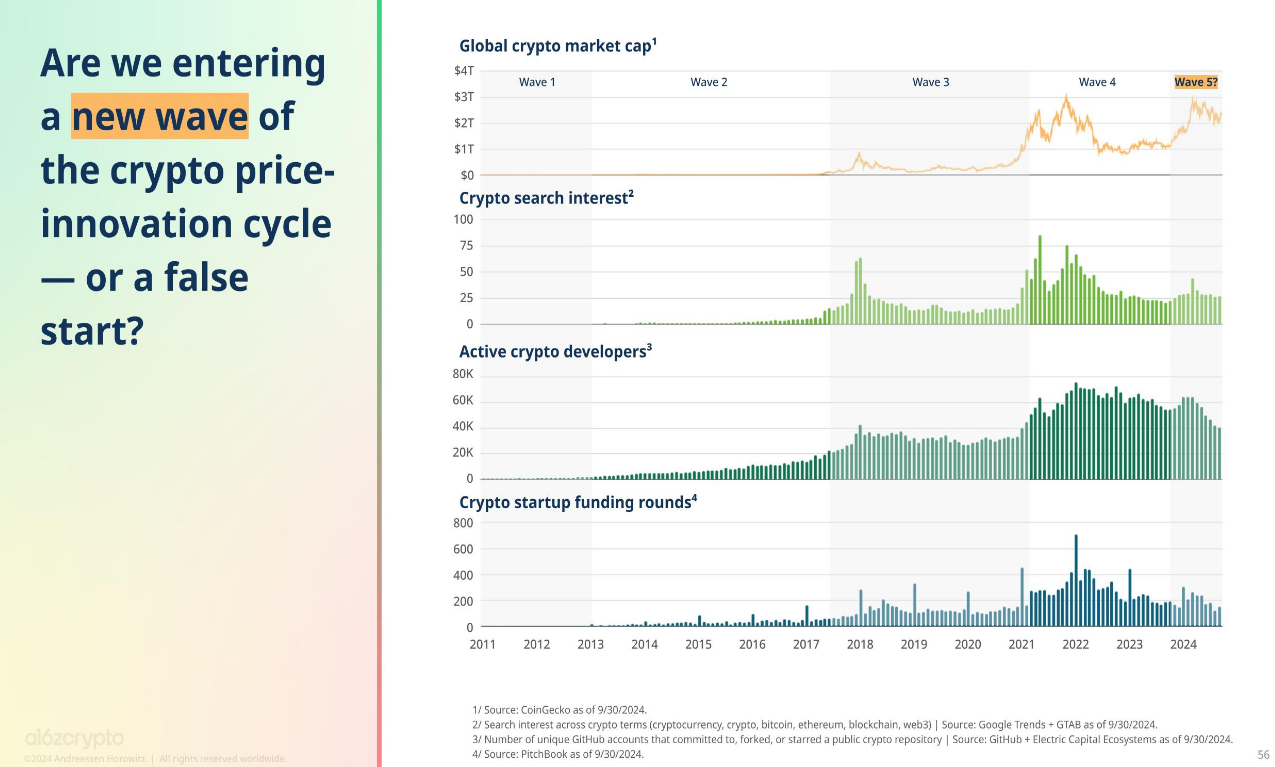
Where will this take us? Over the past year, cryptocurrency has made significant progress in areas such as policy, technology, and consumer adoption. In terms of policy, there have been milestone events, including the sudden approval and listing of Bitcoin and Ethereum ETPs, as well as the passage of important bipartisan crypto legislation. In terms of infrastructure, there have been major advancements, from scaling upgrades to the rise of Ethereum L2 networks and the emergence of other high-throughput blockchains. Additionally, new applications are continuously being built and used, from the growth of mainstream applications like stablecoins to the exploration of emerging categories such as AI, social networks, and gaming.
As for whether we have entered the fifth wave of the price-innovation cycle (which is our framework for understanding the cyclical ups and downs of the crypto market), it remains to be seen. Regardless, as an industry, cryptocurrency has undeniably made progress over the past year. As demonstrated by ChatGPT, a breakthrough product can change an entire industry.
Article link: https://www.hellobtc.com/kp/du/11/5528.html
Source: https://a16zcrypto.com/posts/article/state-of-crypto-report-2024/
免责声明:本文章仅代表作者个人观点,不代表本平台的立场和观点。本文章仅供信息分享,不构成对任何人的任何投资建议。用户与作者之间的任何争议,与本平台无关。如网页中刊载的文章或图片涉及侵权,请提供相关的权利证明和身份证明发送邮件到support@aicoin.com,本平台相关工作人员将会进行核查。




